Traitement du signal
Conception : Benjamin Chaix Antoine Lorenzi
Les aides auditives à conduction aérienne et osseuse peuvent être schématisés en trois étages : microphone, amplificateur/microprocesseur, écouteur (ou vibrateur). Cette partie décrit brièvement comment le signal acoustique est numérisé puis traité grâce aux principes d’échantillonage et de quantification.
Principe de fonctionnement
Le microphone : (de type électret de nos jours) capte les sons environnants et restitue un courant électrique variable à l’étage d’amplification en fonction des variations de pressions sonore reçues. Il s’agit d’un codage analogique (variation de tension en fonction du temps) comparable à la vibration et déformation du tympan en condition normale. Suivant le type d’appareil, on peut retrouver des microphones directionnels ou omnidirectionnels.
L’amplificateur est la partie la plus complexe. Il est constitué de deux sous-étages : microprocesseur et amplificateur.
Le signal analogique reçu est numérisé en suivant des caractéristiques définies : la fréquence d’échantillonnage (A, B, C) (intervalle de temps pour lequel la valeur du signal est prélevée) et le pas de quantification (définissant le nombre de bit) sont responsables de la fidélité du signal numérisé par rapport au signal analogique (D, E, F).
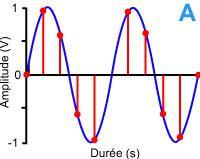
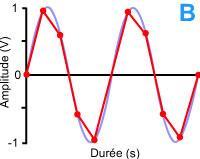
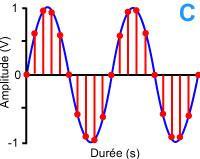
Sur le graphe A, la sinusoïde est échantillonnée à une fréquence d’échantillonnage basse. Ainsi, lorsqu’on relie les points (B), ou échantillons, l’imprécision est importante (courbe rouge par rapport à la courbe bleue). Sur le graphe C, la sinusoïde est échantillonnée à une fréquence d’échantillonnage haute. Ainsi, lorsqu’on relie les points, ou échantillons, l’imprécision est réduite : La courbe rouge se confondra avec la courbe bleue d’origine.
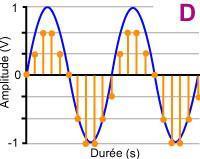
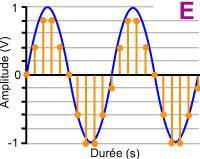
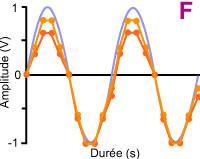
Le graphe D représente une codage insufisant de l’amplitude des échantillons sélectionnés alors que le graphe E présente un codage plus précis pour un échantillonnage équivalent. Plus le pas de quantification est élevé, plus le signal numérisé sera fidèle au signal originel (graphe F) mais le temps de calcul sera plus important.
Un signal numérisé peut alors subir différentes modifications à l’aide d’algorithmes (filtrage, compression, anti-larsen etc) afin de restituer un signal adapté au profil auditif de chaque patient malentendant. :
- Contrôle automatique de gain à l’entrée (AGC I) : ce système permet de contrôler le gain apporté par l’amplificateur en fonction du niveau d’entrée. Plus celui-ci est élevé plus l’amplification diminue.
- Contrôlé automatique de gain à la sortie (AGCO) : tout comme l’AGCI, il contrôle le gain mais cette fois-ci après l’étage d’amplification. Ainsi plus le niveau de sortie est élevé plus le gain diminue. A l’heure actuelle, les AGCI sont préférés pour la régulation du gain alors que l’AGCO est utilisé pour limiter le niveau de sortie de l’appareil. Ce dernier est assimilable à un système d’écrêtage.
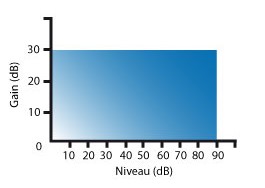
Sur ce graphe on voit l’évolution du gain en fonction du niveau des sons. Il est constant (ou linéaire) jusqu’à 90 dB où le signal est écrêté (taux de compression infini). Cet écrêtage introduit des déformations très importantes sur le signal de sortie.
Aujourd’hui, les nouvelles aides auditives modèlent la valeur du gain en fonction du niveau d’entrée et/ou de sortie. Ainsi, on obtient des amplifications non linéaires dont le but est de se rapprocher de la sensation d’intensité du patient. Cette non-linéarité traduit l’existence d’une compression, déterminée par un taux ; plus il est élevé plus le gain diminue rapidement.
Le plus souvent, le système de limitation du niveau maximal de sortie est assuré par un AGCO à fort taux de compression.
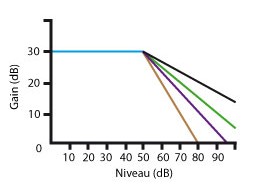
Sur ce graphe, on voit l’évolution du gain en fonction du niveau d’entrée des sons. Il est constant, ou linéaire jusqu‘à 50 dB. Au-delà on distingue une diminution du gain plus ou moins rapide définie par le taux de compression : courbe noire : (1,5 : 1), courbe verte : (2 : 1), courbe violette : (3 : 1).
La courbe marron, quant à elle, représente la limitation de sortie exercée par un AGCO dont le taux de compression serait de 100 et le seuil d’enclenchement à 80 dB.
Lorsque les modifications souhaitées sont réalisées, le signal est à nouveau converti en signal analogique pour être amplifié. L’amplification peut être réalisée en entrée ou en sortie en fonction de la stratégie de réglage.
L’écouteur permet de restituer le signal ainsi transformé. Il est très simplement constitué d’une bobine entourant un électro-aimant. La bobine reçoit les variations de du courant sortant et les induit à une membrane solidaire de l’électro-aimant pour mettre en mouvement les molécules d’air.
Dans le cas des implants d’oreille moyenne, il s’agit le plus souvent d’un petit piston (électro-aimant), fixé sur la branche descendante de l’enclume par voie chirugicale, qui reçoit les variations de courant pour les transmettre mécaniquement au niveau de l’étrier.
Quelques considérations sur le réglage et l’adaptation.
Il est bien évident que dans le cas d’hypoacousies (baisses d’audition), l’amplification de l’intensité sonore devient une nécessité. Cependant, cela ne résout pas tout.
Par exemple, la plupart des patients presbyacousiques souffrent de recrutement : leur dynamique auditive est diminuée, surtout dans les fréquences aiguës. Il faut appliquer une amplification, si possible non linéaire, intégrant une compression du signal afin d’éviter de dépasser le seuil de tolérance.
Cette compression peut être appliquée de manière indépendante sur différents canaux fréquentiels de l’amplificateur. Des systèmes de compression ou transposition fréquentielle existent aussi afin de limiter l’amplification dans les fréquences aigües (les sons entrants à une fréquence supérieure d’une valeur définie (Fc) sont restituées dans une bande de fréquence inférieure à Fc).
L’adaptation d’aides auditives doit être minutieuse. Le professionnel de santé doit apporter son soutien et son encouragement, tant la démarche d’appareillage peut paraître complexe et longue. Le premier contact est très important, une atmosphère de confiance doit s’établir. Il est bon de cerner la personnalité du patient afin d’obtenir les meilleurs résultats et de tenir compte d’éléments annexes comme l’âge, l’habileté manuelle, l’acuité visuelle et la motivation afin d’être au plus proche de ses capacités d’adaptation.